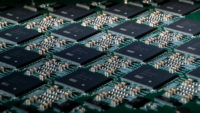Intel, which is in development on its Loihi “neuromorphic” deep-learning chips, just debuted Pohoiki Beach, code name for a new system comprised of 64 Loihi chips and eight million “neurons.” Loihi’s neuromorphism denotes the fact that it is modeled after the human brain, and Pohoiki Beach is capable of running AI algorithms up to 1,000 faster and 10,000 times more efficiently than the typical CPU. Applications could include everything from autonomous vehicles to electronic robot skin and prosthetic limbs.
Engadget reports that, “the Loihi chips are installed on a ‘Nahuku’ board that contains from eight to 32 Loihi chips … [and] the Pohoiki Beach system contains multiple Nahuku boards that can be interfaced with Intel’s Arria 10 FPGA developer’s kit.”

Pohoiki Beach is expected to excel at “neural-like tasks including sparse coding, path planning and simultaneous localization and mapping (SLAM)” — algorithms required for autonomous vehicles, “indoor mapping for robots and efficient sensing systems.”
Intel is already using the boards to make more adaptable prosthetic legs, power object tracking with new event cameras, give tactile input to an iCub robot’s electronic skin and automate a foosball table. In these tasks, the Pohoiki system consumed a lot less power but performed as well as GPU/CPU-based systems. Intel plans to unveil a Pohoiki Beach system that is “over ten times larger, with up to 100 million neurons.”
VentureBeat describes neuromorphic engineering, also known as neuromorphic computing, as “the use of systems containing electronic analog circuits to mimic neuro-biological architectures present in the nervous system.” At HP, IBM, MIT, and Stanford, among other sites, scientists have “pioneered pieces of full-stack systems” in an effort to attain the goal of much more powerful supercomputers.
One example is Intel’s Pohoiki Beach, which Intel debuted at the Defense Advanced Research Projects Agency’s (DARPA) Electronic Resurgence Initiative 2019. According to Intel Lab managing director Rich Uhlig, the company will make Pohoiki Beach available to 60 “ecosystem” partners.
It describes Pohoiki Beach as comprised of “64 128-core, 14-nanometer Loihi neuromorphic chips … [with] 60-millimeter die size and contain[ing] over 2 billion transistors, 130,000 artificial neurons, and 130 million synapses, in addition to three managing Lakemont cores for task orchestration.”
Loihi also “features a programmable microcode learning engine for on-chip training of asynchronous spiking neural networks (SNNs),” which are “AI models that incorporate time into their operating model.” VB adds, “the Loihi development toolchain comprises the Loihi Python API, a compiler, and a set of runtime libraries for building and executing SNNs.”
“With [Loihi], we’ve been able to demonstrate 109 times lower power consumption running a real-time deep learning benchmark compared to a GPU, and five times lower power consumption compared to specialized IoT inference hardware,” said Applied Brain Research co-chief executive Chris Eliasmith, who is also a professor at University of Waterloo.
For more information and images, visit the Intel Newsroom.

No Comments Yet
You can be the first to comment!
Sorry, comments for this entry are closed at this time.